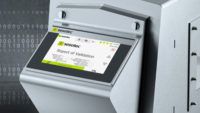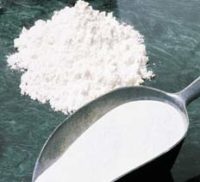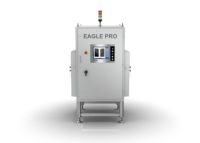The market for technologies to trace consumable products such as foods and drugs is driven by three forces. The first is the safety of foods and drugs, which must be continuously monitored and occasionally recalled to prevent intrinsic or emerging pathogens, or human error during production processes, from adulterating the product and harming the consumer. The second is the security of foods and drugs, which is increasingly threatened by theft, counterfeiting, adulteration and the possibility of terrorism. The third is consumer demand for traceability, which reflects public perception of the safety and security of foods and drugs, as influenced by local cultural and economic factors. Consumer demand for traceability, agricultural or pharmaceutical, is expressed directly at the cash register by willingness to pay for it, and expressed indirectly through government regulations and import/export policies.
The globalization of both the food and drug industries has substantially increased each of these forces. Control needed to assure the safety and security of any manufactured product diminishes over distance, and traceability is needed to compensate for this loss of control. Furthermore, when a product is marketed in many countries, it must meet consumer, regulatory and border protection agent standards in each of those countries. As a result, the most stringent requirement in any of these countries becomes the de facto standard for them all.
However, the market for tracing technologies has been restrained by three complementary forces. The first is cost, which is particularly important in the low-margin, high-volume food business. However, globalization and the Internet make this issue prominent in the drug industry, as well, as the debate over reimportation of pharmaceuticals illustrates. The second is skepticism, by some manufacturers but also by some consumers, about whether the symbolic benefits of traceability to the consumer are accompanied by meaningful consumer benefits, such as increased product safety or availability. The third is concern that facilitating traceability back to the manufacturer will facilitate tracing product liability back to the manufacturer, as well.
To overcome these restraints, marketers of tracing technologies need to develop value propositions for their products. For food safety, the proposition might be that the opportunity to perform a more efficient recall or lookback can lower the overall cost of quality control and quality assurance. For food security, the proposition might be that the presence of an overt or covert marking system either deters or increases recovery from theft or terrorism. For customer demand, the proposition might be that the premium the consumer is willing to pay exceeds the increased exposure to product liability claims.
Fortunately for inventors and entrepreneurs, as long as there is a value proposition for tracing technologies, there will be a value proposition for new tracing technologies. This is because the life cycle of all defensive technologies is finite, and tracing technologies are fundamentally defensive technologies. The U.S. Bureau of Engraving and Printing, for example, estimates the life cycle of an anticounterfeiting technology to be seven years.
The other value proposition for new tracing technologies—besides change to keep ahead of criminal technology—is technological improvement itself. Tracers should in general be first, small in relationship to the item marked, which for unit portions of food and doses of drugs generally means microscopic; second, biodegradable and when used to mark foods and drugs, edible; third, secure, which fundamentally means capable of carrying a large amount of information; fourth, easily detected and easily read; and fifth, very, very cheap. The markets for tracers with all five of these attributes is far from saturated.
The Dec. 23, 2003, discovery of bovine spongiform encephalopathy (BSE) at a domestic food processing facility and the Feb. 18, 2004 Report of the U.S. Food and Drug Administration (FDA) on Combating Counterfeit Drugs have provided fresh opportunities for developers of new tracing technologies to promote their products. FDA has proposed that radio frequency identification (RFID) of pallets and packages of prescription drugs become standard by 2007, and RFID could be widely adopted as the movement towards a national animal identification program progresses. The FDA has also proposed that “authentication” technologies, which include tests for specific attributes of a product itself or detection of identifiers on the product itself, rather than on its packaging, can now serve as a critical component of an identity preservation program.
Current Tracing Technologies
One way to classify the many tracing technologies that can be used for foods and drugs is to divide them into package markers and product markers. Package markers can be subdivided into bar codes, RFID devices, and what can be called for convenience currency protection measures, because that is their most obvious market.
Bar codes were first used in supermarkets on June 26, 1974. In the following 30 years, the Uniform Code Council (www.uc-council.org), which oversees their use, has stated that bar codes have saved $1 trillion dollars worldwide in checkout and—more importantly—inventory control costs. Printers and readers for the standard one-dimensional (1D) linear bar code, which carries 12 numbers, can be purchased for well under $100 each. Two-dimensional (2D) bar code printers and readers are somewhat more expensive, but 2D codes can carry far more information, about 2,000 alphanumeric characters in a 2-inch by 2-inch space. However, the ready availability of 1D and 2D equipment makes these codes easy to counterfeit.
RFID devices are basically bar codes that do not have to be seen to be read. An RFID reader, which costs about 10 times as much as a bar code reader, sends a radio frequency signal that are recognized by RFID devices within a few feet. The RFID devices then send signals (on different frequencies) back to the RFID reader, which picks up the signals from the devices and decodes them. “Passive” RFID devices absorb and use the energy from the reader signal to transmit their response, while “active” RFID devices have their own power supply. The use of RFID devices is rapidly expanding, but cost per device, even for passive devices, remains an impediment to their replacing bar codes, and RFID devices also are not technically difficult to counterfeit.
Currency protection measures can be subdivided into two further categories. The first is paper markers, such as special fibers used to make the paper, threads embedded in the paper (which may have special properties, such as magnetism, of their own), and watermarks, dyes, or taggants placed on the paper during or after manufacture. The other category is print markers, which include a wide variety of inks, for example photochromic or thermochromic pigments; holograms or steganograms; and lasered perforations.
Product markers can be subdivided into intrinsic properties of the product, and markers placed directly on the product. The classic intrinsic property is the fingerprint, now augmented by retinal scans and facial recognition algorithms. For inanimate objects such as food, unique nucleic acids, particularly mitochondrial nucleic acids, along with unique proteins (e.g., prions), are the intrinsic properties most commonly traced. Markers placed on a product can be either physical, chemical or biological. Physical markers include atoms with unique signatures that can be detected by X-ray fluorescence. Chemical markers include those that create a distinct flavor, aroma or absorbance spectrum; for example, a vitamin placed in an alcoholic beverage. Biological markers include nucleic acids, such as plant DNA, or microorganisms, either naturally occurring or added during production. The microorganisms, either natural or engineered, can possess indicators that can detect changes in the product, or attempts to subvert it.
Issues and Forward Motion
Several issues remain unsettled as tracing technology develops. First, are bar codes obsolete? Bar code readers and generators are ubiquitous, so the codes themselves are trivially easy to generate. However, if bar codes are obsolete, can the obsolescence of RFID chips, which are also ubiquitous and only slightly less easy to manufacture, be far behind? Second, how much focus should be placed on assuring the integrity of a product’s packaging, and how much on the integrity of the product itself, in the evaluation of new tracing technologies? This depends on the answer to two related questions: Is there truly such a thing as “tamper-proof” or “tamper-evident” packaging, and if so, how do you enable major consumer groups such as the elderly and the disabled to use these technologies? Third, what is the optimum mixture of overt and covert marking technologies? Holograms are overt, established, generally analog, and hard but not impossible to counterfeit; steganograms, which are pictures embedded within pictures, are covert, fairly new, digital, and impossible to counterfeit without a digital key (but trivial to counterfeit with the key). Fourth, how do we deal with the inevitable false positives and false negatives that will accompany all of these technologies, RFID and nucleic acid technologies, in particular? The predictive value of a positive or negative test–whether, say, a positive test is a “true” positive, or whether the item tested is actually negative–can vary widely under different real-world circumstances, such as the expected rate of positive tests. For example, the lower the expected rate of positive tests, the lower the chance that a positive test is a true positive. Fifth, RFID and nucleic acid identification technologies appear to be quite robust at their current level of market penetration, but will they remain so if their penetration increases by one, or even two, orders of magnitude?
The new tracing technologies are uniformly ingenious. However, the market for ingenuity itself, as many inventors and entrepreneurs can attest, is limited, so the success in this market will be limited to those who can match their technology to a specific and urgent need, and to do so at a negligible unit price. It could happen that a single tracing technology will emerge, like MicroSoft Windows, from the current technologic bazaar, but that would give hackers, counterfeiters, thieves and terrorists only one target, and the survivability of a single target under such an attack is dubious. The more likely alternative, then, is that individual technologies will survive or even thrive in particular niches, such as backing up RFID, based on the suitability of the technology for a particular niche, and the aggressiveness of the marketing of these technologies to a particular niche. That is what those of us entering this market anticipate.
There are ways to place microscopic bar codes, or the information content of a bar code, on an edible product itself. One is to stamp a binary pattern on to the material. The other is to score a binary pattern on an edible material while it is being extruded into a fiber, and then cut the extruded fiber into thin discs, revealing the pattern. Examples of these markers on a soybean and ground beef are shown in Figure 1.
At the present time, drug traceability is much closer to actual implementation on a national basis than food traceability. The FDA has established 2007 as the year when all drugs should have RFIDs down to the package level, and when tests that authenticate the product itself will have reached the market. It is worth noting by the food industry that the market driver for this action was drug security, and not drug safety. Even though the Institute of Medicine published a report in 1999 that claimed almost 100,000 Americans die every year because of medication errors, the recommendation for drug traceability was driven by the need to combat counterfeiting, and not by the need to reduce errors in drug administration.
The food industry may well take the same path. The major producers in the food industry with whom we have discussed traceability believe, with substantial justification, that their products are safe, at least when they are under their own control. For this reason, such interest as they have expressed in tracing technology has been whether it would save money elsewhere in their quality control or quality assurance programs. On the other hand, these same producers take cargo theft and the threat of terrorism extremely seriously, and they are quite receptive to technologies that improve food security. Consumer demand, and in particular offshore consumer demand, for greater traceability of foods based on safety considerations may eventually be met by industry adoption of greater traceability of foods based on security considerations.
Dr. Stephen Nightingale was educated at Harvard College and the University of Pennsylvania School of Medicine. He trained in internal medicine and nephrology at the Johns Hopkins Hospital. In addition to serving as the Chairman of the Division of General Internal Medicine at Cook County Hospital in and the Medical Director of the AIDS Clinic at Parkland Memorial Hospital, he was the Senior Medical Officer for Blood Safety with the Office of the Secretary of the Department of Health and Human Services before leaving in August 2002 to form Burntside Partners, Inc.
New Technologies for Food Traceability: Package and Product Markers




